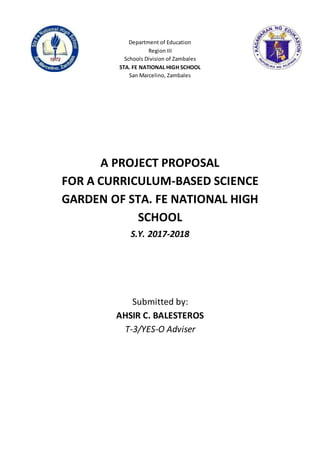
A proposal for a curriculum.
- 1. Department of Education Region III Schools Division of Zambales STA. FE NATIONAL HIGH SCHOOL San Marcelino, Zambales A PROJECT PROPOSAL FOR A CURRICULUM-BASED SCIENCE GARDEN OF STA. FE NATIONAL HIGH SCHOOL S.Y. 2017-2018 Submitted by: AHSIR C. BALESTEROS T-3/YES-O Adviser Republic of the Philippines RegionIII Divisionof Zambales SANGUILLERMONATIONAL HIGH SCHOOL SanMarcelino
- 2. Introduction: Imagine a science garden that students and facultyshow off with pride, not only because of itsbeautybut because itenablesawhole new setof learningexperiencesforstudents.We canmake this vision a reality at STA. FE NATIONAL HIGH SCHOOL with the initiating effort of its school organization in science, the Youth for Environment in Schools Organization (YES-O). Our school hasthe potentialtoenhance studentlearningoutside of the classroom asmuchas it does inside. A curriculum-based science garden with its own fishpond could serve as a living laboratoryandoutdoorclassroomfor subjectsacrossthe curriculumrightinour ownschool campus. Sta.Fe National Highschool isattendedbythe studentwithadifferentlevelof environmental awareness aboutthe interdependenceamongthe componentof the environmentthe livingandnon- living things.We would like to enrich our studentsin our school by creating a science garden with a fishpond thatbringsstudents the learningexperiencewith plantsandanimals (Biotic) havingahealthy relationshipwiththe material inthe environment(Abiotic) ina so-calledhabitat.Inthe process,they can participate in activities that increase science knowledge, sharpen their experimental skills, spur curiosityand create awarenessaboutthe environmental conditionof the communityandthe country as well. Project Rationale and Objective: The Youth for Environment in Schools Organization (YES-O) is the premier student organization in the school that concerned for environmental welfare. Just like any other environmental organizations, we do have the goal to create awareness about the environmental condition of the country among the Filipino students, establish doable and specific projects for environmental wellness,and promote environmental advocacies in our schools. And one of these projectsof the Sta.Fe NationalHighSchoolYouthforEnvironmentOrganization istoput-upafishpond that aims to provide an opportunity for the student to experience and be able to acquire necessary skills and knowledge pertaining to specific competencies based on the curriculum guide. The Curriculum-basedScience GardenFishpondof Sta.Fe NationalHighSchool objectivesare as follow: 1. (S7LT-IIh-9) differentiate biotic from abiotic components of an ecosystem; 2. (S7LT-IIh-10) describe the different ecological relationships found in an ecosystem; 3. (S7LT-IIi-11) predict the effect of changes in one population on other populations in the ecosystem; and 4. (S7LT-IIj-12) predict the effect of changes in abiotic factors on the ecosystem. Educational Benefits of Curriculum-Based Science Garden Fishpond: There is no implied guidelines or explicit requirement for a school to incorporate a science garden to science (academic) lessons, and yet, science teachers still make science garden a part of where andhowtofacilitatealesson. Eventhoughthere are noexactresourcestosupportthe supplies and preparationof a science garden, science teacherswill come up with othermeansto provide the necessarymaterialtoputupascience garden.Becausetheyare integratingscience garden-basedinto
- 3. theirlessonplan, organizingthe classforlessonsoutside,andfindingwaystoconnecttheirstudents’ outdoor learning experience to the curriculum-based science garden. Science garden is now a necessity in teaching the different discipline of science especially biology.Science teachersnowrealizedthatthe sciencegardenis suitedtohelpchildrenlearn.It could provide chances to contextualize a lesson for understanding both simple and complex concepts throughlocalizationandindigenization. “Itisaplace where studentspractice skillslike measurement, scientificobservation,informative writing,andpoetry.Of course,theseare skillsthatcanbe taughtin many ways,but teachersfindthat the school gardenis a particularlyengagingenvironmentfortheir students. Garden-based learning can bridge academic subjects in a way that not only imparts skills and contentbut alsohelpsstudentsunderstandwhythese skillsare importantand how theycan be useful. Further, the edible learning garden allows teachers to “fold in” health and food education without competing with core academic time. The schoolyard garden is a sensory-rich change in environment from the classroom, and it is just outside the door”. (By Jane S. Hirschi | May 2015) Now a science garden can transform the schoolyard into an outdoor learning laboratory, essentiallyanew“classroom”withendlessopportunitiesforinvestigationandstudy,forrelativelylow cost whencompared to the costs of constructinga new science lab classroom. A science gardencan be built and used to meet learning standards. Not just content standards but also performance standards for teaching and learning instruction that are student-centered involving active investigations that rely on students’ own environment as a contextualization for learning. Plan of Action: Construction: Phase One Activities Time Frame Person involved Expected Output Generating fund June to December 2017 YES – O Members Income from “MONEY ON WASTE” Project Site preparation December 2017 YES – O Members Ground clearing and leveling Construction January 2018 YES – O Officers and Parents Rectangular Fishpond Installation: Phase Two Activities Time Frame Person involved Expected Output Landscaping February-March, 2018 YES-O officers, Members, and Parents Curriculum-based Science Garden
- 4. Installing of Fish (Tilapia) February 2018 YES-O Adviser Fully Functional Fishpond Funding: The potential source of fundforthisprojectismainlyfrom aportionof the generatedincome of "MONEY ON WASTE"projectof the organization(YES-O) forSchoolYear2016-2017 and2017-2018. The estimatedcostof theprojectisaroundPhp3,450.00 for phase one of the project.Andthisamount isfor the provisionof the necessarymaterialsforthe constructionandlaborcostwhichisstill subject to some adjustmentbasedon the availabilityof potentialdonorsandlaborvolunteersfrom parents. Conclusion: The basic goal of a school garden is the aesthetic value. Bounded withthe varietyof plants arranged in a beautiful landscape is a typical view as expected. But for a curriculum-based science garden, it exceeds this expectation for it provides limitless possibilities for both aesthetic and educational value. To restate, it transforms a schoolyard into an outdoor learning laboratory, a sensory-rich change in environment from the classroom that provides chances to contextualize a lesson for understanding both simple andcomplex concepts throughlocalizationandindigenization,aplace for activitiesthat increase science knowledge, sharpen their experimental skills, spur curiosity and create awareness aboutthe environmentalconditionof ourmotherearth.Toconclude,ascience gardenhasalongterm benefitthatwill transpire through all academicsubjectswhich supportlessonsingeography,writing, and social studies. Prepared by: AHSIR C. BALLESTEROS Teacher 3/ YES-O Adviser Approved: DONABEL N. FERIA Head Teacher 3/OIC